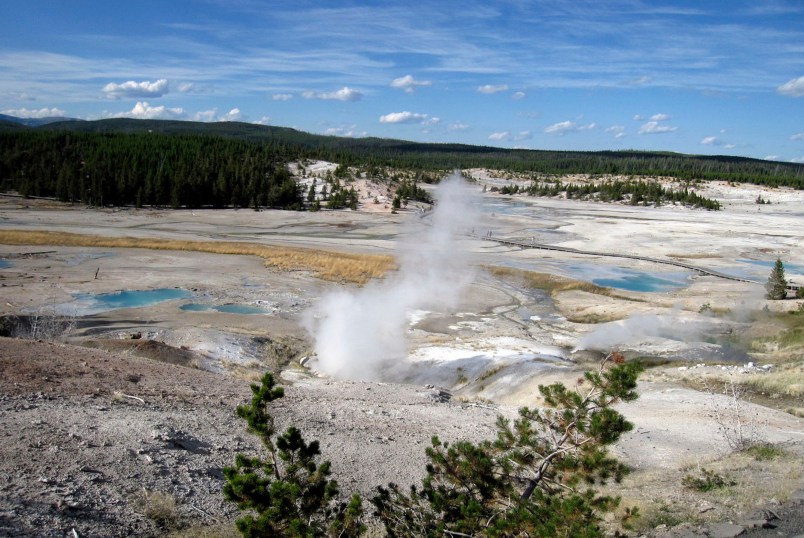BILLINGS, Mont. (AP) — The grisly death of a tourist who left a boardwalk and fell into a high-temperature, acidic spring in Yellowstone National Park offers a sobering reminder that visitors need to follow park rules, park officials and observers said.
Efforts to recover the body of Colin Nathaniel Scott, 23, of Portland, Oregon, were suspended on Wednesday after rangers determined there were no remains left in the hot spring.
Scott’s death follows a string of incidents raising questions about tourist behavior at the nation’s first national park as visitor numbers surge. That includes people getting too close to wildlife and entering dangerous areas in violation of regulations.
Yellowstone Superintendent Dan Wenk said visitors must keep to designated boardwalks when moving among the park’s hot springs and geysers that blast steaming water high into the air.
Scott and his sister had traveled about 225 yards off the boardwalk on Tuesday when he slipped and fell into the hot spring in the Norris Geyser Basin. Officials said the pair had left the boardwalk to get closer to some of the basin’s thermal features.
“This tragic event must remind all of us to follow the regulations and stay on boardwalks,” Wenk said.
After Scott’s sister reported the fall, rangers navigated over the highly-fragile crust of the geyser basin to try to recover his body. They halted the effort “due to the extreme nature and futility of it all,” said park spokeswoman Charissa Reid, referring to the high temperature and acidic nature of the spring.
The death occurred in one of the hottest and most volatile areas of Yellowstone, where boiling water flows just beneath a thin rock crust.
It follows high-profile incidents at the rugged park in which tourists got too close to wildlife or went off designated pathways onto unique landmarks, sometimes leading to injuries.
“It’s sort of dumb, if I could be so blunt, to walk off the boardwalks not knowing what you’re doing,” said Kenneth Sims, a University of Wyoming geology professor and member of the Yellowstone Volcano Observatory.
“They’re scofflaws essentially, who look around and then head off the boardwalk,” he added. Sims said he was speaking generally and had no direct knowledge of the circumstances of Scott’s death.
Scott previously worked as a volunteer at the Jackson Bottom Wetlands Preserve in Oregon, said Mary Loftin, a manager at the Hillsboro, Oregon, parks and recreation department. Scott worked there for about 20 months fielding questions from visitors, and his stint ended last year, she said.
“A very nice young man; a bright spirit,” Loftin said.
The basin is a popular attraction in the nation’s first national park, which received a record 4.1 million visitors last year. Water temperatures there can reach 199 degrees, the boiling point for water at the park’s high elevation.
At least 22 people are known to have died from hot spring-related injuries in and around Yellowstone since 1890, park officials said.
Most of the deaths have been accidents, although at least two people had been trying to swim in a hot spring, park historian Lee Whittlesey, author of the book “Death in Yellowstone.”
The crust that makes up the ground in parts of Yellowstone is formed when minerals underground are dissolved by the high-temperature water, then redeposited on or near the surface.
That crust can be as “thin as a skiff of ice” Reid said.
Other recent tourist incidents at Yellowstone include a 13-year-old boy who got burned Saturday when his father, who had been carrying him, slipped into a different hot spring.
___
Follow Matthew Brown on Twitter at —https://twitter.com/matthewbrownap
Copyright 2016 The Associated Press. All rights reserved. This material may not be published, broadcast, rewritten or redistributed.







Even the human heard needs to be culled and Yellowstone affords an opportunity to do just that. In the modern world the weak and the dumb are often preserved and protected from natural selection to the detriment of us all. I feel sorry for this man’s sister and family, but I’ve been to these hot springs and the need to stay on the walkways could not be more obvious.
Headline: Gruesome Hot Spring Death Highlights Problems At Yellowstone
There is no problems at all with Yellowstone save for too many navel gazing self absorbed people are too fucking stupid to even be breathing.
He was a very nice young man . . . . .who got himself killed. Tragic, but hardly the fault of the Park.
Sorry for the family’s loss. That being said, you just can’t fix stupid. Even my own son, who went to see a volcano up close in Guatemala, figured he should probably leave once his sneakers started to melt. I shake my head to this day.
Anybody who spends time doing outdoors stuff can tell you stories similar to this, but national parks seem to have a special attraction for people who ignore clearly posted risks. People will put their young children on the famous wild ponies at Chincoteague right the hell next to a sign that says “Wild ponies kick and bite do not etc…” They’ll play around with dumpster bears, teasing them and so forth. Yellowstone is the worst, though. Bison and elk are big, dangerous animals, but people treat them like it’s a petting zoo. This young guy’s death was unfortunate and rather grisly but I’m absolutely sure he walked past three or four warning signs on his way to it.